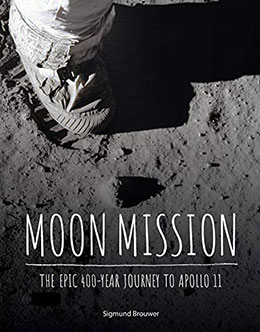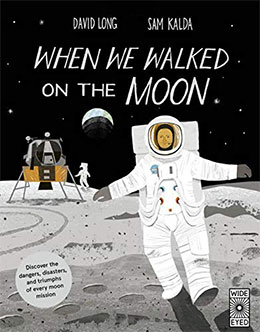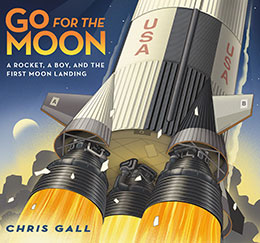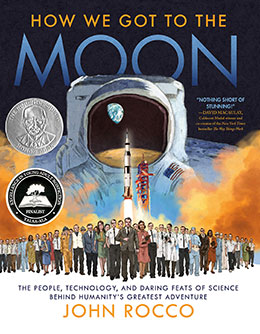The fiftieth anniversary of the Apollo 11 moon landing in July 2019 inspired many new books along with some updates and reissues of existing titles. For those who haven’t had the chance to look at all the possibilities, let me introduce you to a few.
 Moon Mission: The Epic 400-Year Journey to Apollo 11 by Sigmund Brouwer (Kids Can Press May 7, 2019) The book is organized into ten episodes ranging from liftoff to the journey’s end. The challenges of each stage of the flight are explained along with discussions of previous discoveries and theories that helped make the Apollo program possible. Readers are invited to solve mysteries about STEM and to name the people involved. Although many of those mentioned are men, notable females such as Emmy Noether and Margaret Hamilton are also included. Plentiful black and white archival photos and other images support the text. There is also a lengthy list of resources. Recommended for middle school.
Moon Mission: The Epic 400-Year Journey to Apollo 11 by Sigmund Brouwer (Kids Can Press May 7, 2019) The book is organized into ten episodes ranging from liftoff to the journey’s end. The challenges of each stage of the flight are explained along with discussions of previous discoveries and theories that helped make the Apollo program possible. Readers are invited to solve mysteries about STEM and to name the people involved. Although many of those mentioned are men, notable females such as Emmy Noether and Margaret Hamilton are also included. Plentiful black and white archival photos and other images support the text. There is also a lengthy list of resources. Recommended for middle school.
 When We Walked on the Moon: Discover the dangers, disasters, and triumphs of every moon mission by David Long and Sam Kalda (Wide Eyed Editions June 4, 2019) “More than 5,000 rockets have been blasted into space, but only twelve people have ever been lucky enough to walk on the moon and look up at Earth.” This title offers a survey of Apollo missions 11 to 17 and describes the highlights of each. A final chapter discusses the legacy of the Apollo program. Color illustrations are done in a retro, graphic design style. Some are small images such as a closeup of the moon buggy, while others are two-page spreads like the one showing mission control. Back matter includes a page on each of the featured missions with an image of the crew and biographical sketches of the astronauts. A glossary and a timeline are also provided. Not as technically dense as Mission Moon, this is more suited to upper elementary grades.
When We Walked on the Moon: Discover the dangers, disasters, and triumphs of every moon mission by David Long and Sam Kalda (Wide Eyed Editions June 4, 2019) “More than 5,000 rockets have been blasted into space, but only twelve people have ever been lucky enough to walk on the moon and look up at Earth.” This title offers a survey of Apollo missions 11 to 17 and describes the highlights of each. A final chapter discusses the legacy of the Apollo program. Color illustrations are done in a retro, graphic design style. Some are small images such as a closeup of the moon buggy, while others are two-page spreads like the one showing mission control. Back matter includes a page on each of the featured missions with an image of the crew and biographical sketches of the astronauts. A glossary and a timeline are also provided. Not as technically dense as Mission Moon, this is more suited to upper elementary grades.
 Go for the Moon: A Rocket, a Boy, and the First Moon Landing by Chris Gall (Roaring Brook Press June 11, 2019) A young boy’s interest in the moon landing frames the explanations offered to readers. A change in font signals when the narrator is speaking for himself and when historical and technical details are being shared. Explanations are presented in simple, clear language. Colorful, large format illustrations will draw readers in and have them carefully examining every detail. An image of the Statue of Liberty is placed next to the Saturn V rocket to help show its size. Details of the space suits are carefully labeled and so is a cutaway view of the Columbia. Insets depict the narrator’s parallel journey — launching rockets in his backyard, sipping Tang in his cardboard spacecraft, or sitting in front of the television to watch the landing (wearing his own NASA costume). An author’s note includes a photo of the author with a collection of model rockets he has assembled. There is also a page of additional fun facts and a glossary. Recommended for elementary grades.
Go for the Moon: A Rocket, a Boy, and the First Moon Landing by Chris Gall (Roaring Brook Press June 11, 2019) A young boy’s interest in the moon landing frames the explanations offered to readers. A change in font signals when the narrator is speaking for himself and when historical and technical details are being shared. Explanations are presented in simple, clear language. Colorful, large format illustrations will draw readers in and have them carefully examining every detail. An image of the Statue of Liberty is placed next to the Saturn V rocket to help show its size. Details of the space suits are carefully labeled and so is a cutaway view of the Columbia. Insets depict the narrator’s parallel journey — launching rockets in his backyard, sipping Tang in his cardboard spacecraft, or sitting in front of the television to watch the landing (wearing his own NASA costume). An author’s note includes a photo of the author with a collection of model rockets he has assembled. There is also a page of additional fun facts and a glossary. Recommended for elementary grades.
 How We Got to the Moon: The People, Technology, and Daring Feats of Science Behind Humanity’s Greatest Adventure by John Rocco (Crown Books for Young Readers October 6, 2020) This book covers events from Sputnik’s launch to the parades celebrating the return of the Apollo 11 crew. The various aspects of the Apollo program are described and shown in detailed illustrations. Famous figures like Wernher von Braun are introduced to readers, as well as the often overlooked contributions of women and minorities. The variety of historical images have been recreated in the author’s own style offering readers the optimum amount of detail for comprehension and enjoyment and unifying the visual style. Diagrams show orbital intricacies and all the complex equipment required for the program. Notes about the research process, a source list, and a chart of Apollo missions are included in the back matter. Endpapers show a map of the moon with all the landing sites marked and an incredible montage of essential figures. This is a stunning, richly depicted historical narrative. Intended for grades 5 and up, this book would also be at home on the shelf of NASA enthusiasts of any age.
How We Got to the Moon: The People, Technology, and Daring Feats of Science Behind Humanity’s Greatest Adventure by John Rocco (Crown Books for Young Readers October 6, 2020) This book covers events from Sputnik’s launch to the parades celebrating the return of the Apollo 11 crew. The various aspects of the Apollo program are described and shown in detailed illustrations. Famous figures like Wernher von Braun are introduced to readers, as well as the often overlooked contributions of women and minorities. The variety of historical images have been recreated in the author’s own style offering readers the optimum amount of detail for comprehension and enjoyment and unifying the visual style. Diagrams show orbital intricacies and all the complex equipment required for the program. Notes about the research process, a source list, and a chart of Apollo missions are included in the back matter. Endpapers show a map of the moon with all the landing sites marked and an incredible montage of essential figures. This is a stunning, richly depicted historical narrative. Intended for grades 5 and up, this book would also be at home on the shelf of NASA enthusiasts of any age.
